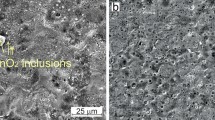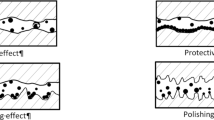Abstract
THE suggestion1 that the failure of lubrication in gears is caused by the actual contact temperature reaching a critical value (150° to 200° C) at which the desorption of surface active compounds present in oils occurs has been supported2 by evidence obtained from modified ‘Bowden–Leben’ friction apparatus. With mineral oils, the friction change could not be observed in this apparatus with a tool-steel friction pair, but it showed up sharply with stainless steel (18 per cent chromium, 8 per cent nickel). The mechanism of the difference between the two is the subject of this communication.
This is a preview of subscription content, access via your institution
Access options
Subscribe to this journal
Receive 51 print issues and online access
$199.00 per year
only $3.90 per issue
Buy this article
- Purchase on SpringerLink
- Instant access to full article PDF
Prices may be subject to local taxes which are calculated during checkout
Similar content being viewed by others
References
Askwith, T. C., Cameron, A., and Crouch, R. F., Proc. Roy. Soc., A, 291, 500 (1966).
Grew, W., and Cameron, A., Nature, 214, 429 (1967).
Niemann, G., and Lechner, G., Erdöl Kohle, Erdgas, Petrochem., 20, 96 (1967).
Groszek, A. J., and Palmer, A. J., J. Inst. Petrol., 47, 295 (1961).
Author information
Authors and Affiliations
Rights and permissions
About this article
Cite this article
GREW, W., CAMERON, A. Role of Austenite and Mineral Oil in Lubricant Failure. Nature 217, 481–482 (1968). https://doi.org/10.1038/217481a0
Received:
Revised:
Published:
Issue date:
DOI: https://doi.org/10.1038/217481a0
This article is cited by
-
In Situ Observation of Heat Generation Behaviour on Steel Surface During Scuffing Process
Tribology Letters (2018)
-
Complex Impedance Measurement Applied to Short-Time Contact Between Colliding Steel Surfaces
Tribology Letters (2015)
-
Effect of Heating Rate in Low Speed Sliding Experiments
Nature Physical Science (1971)



